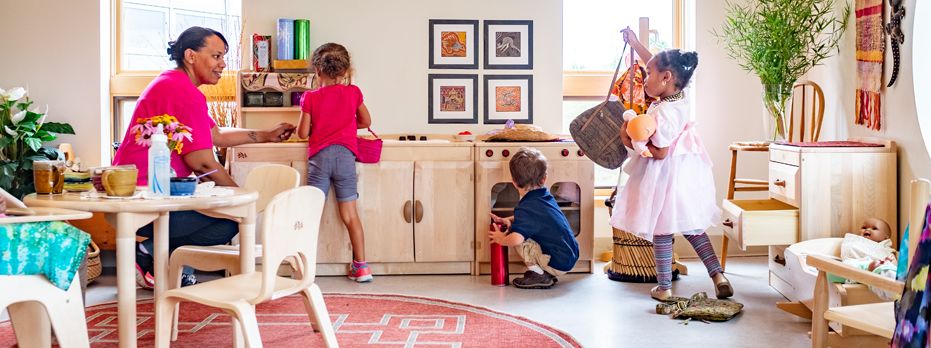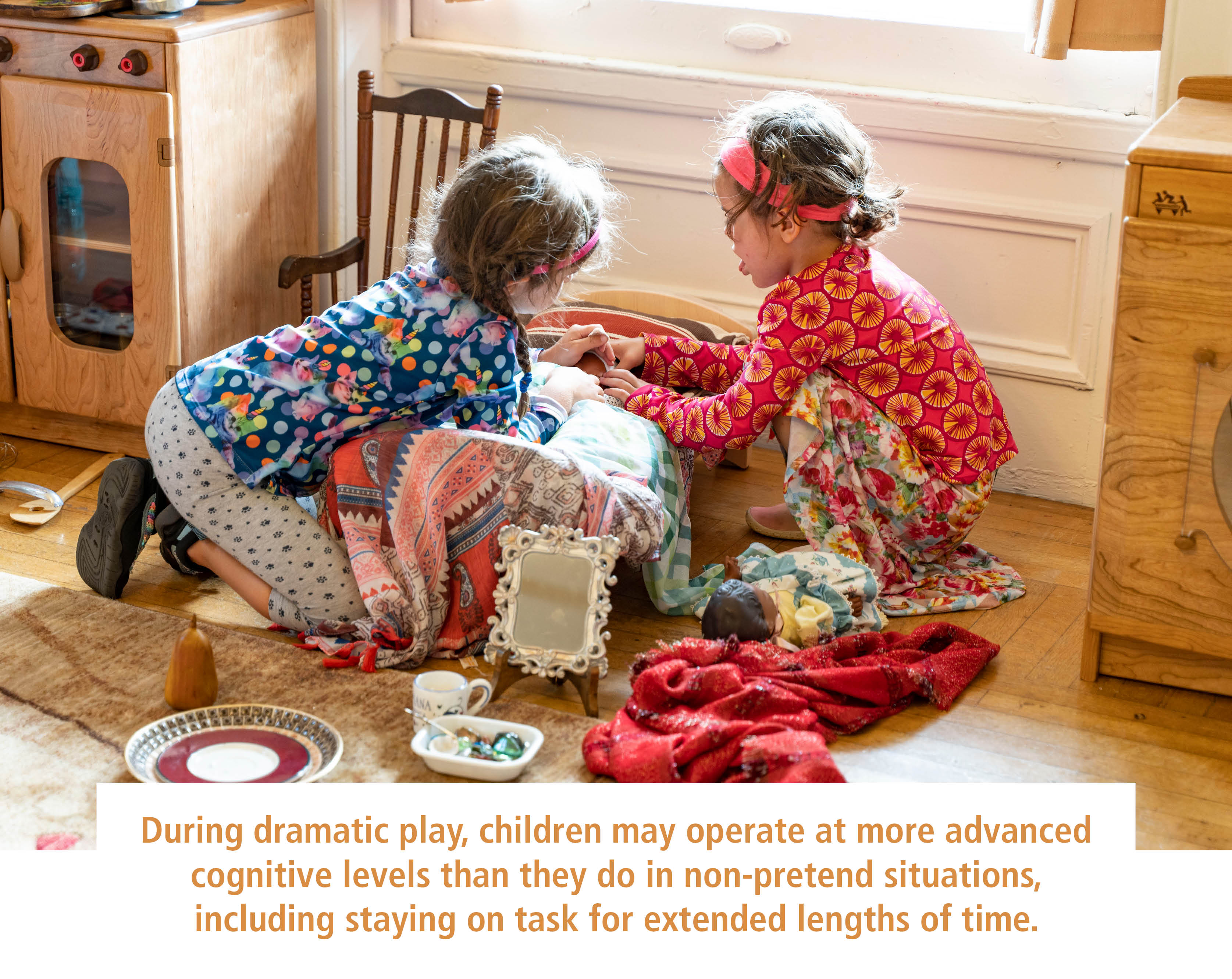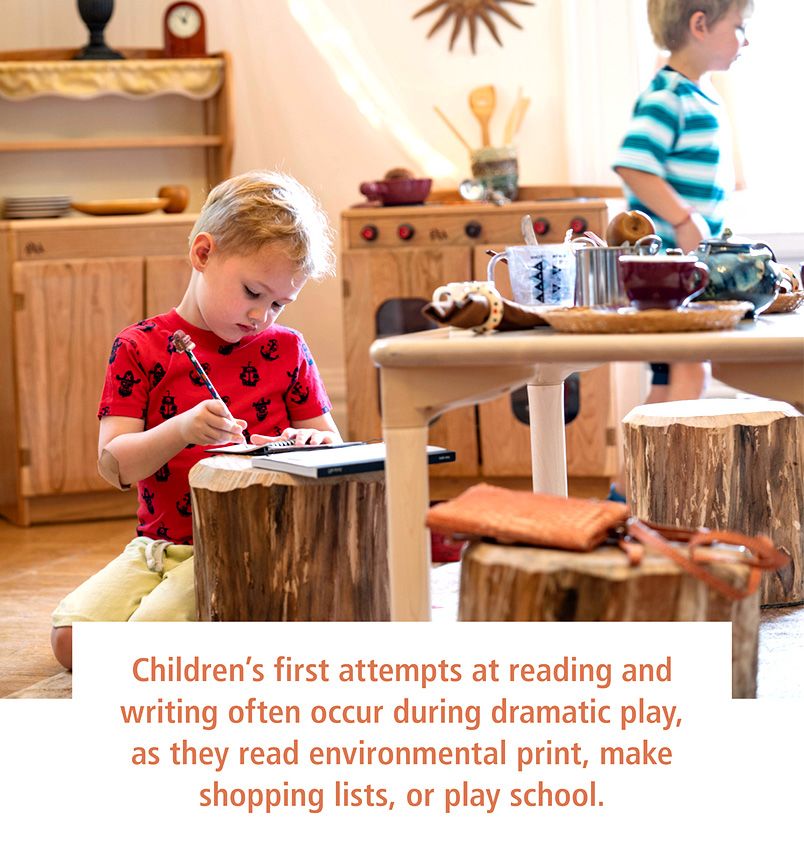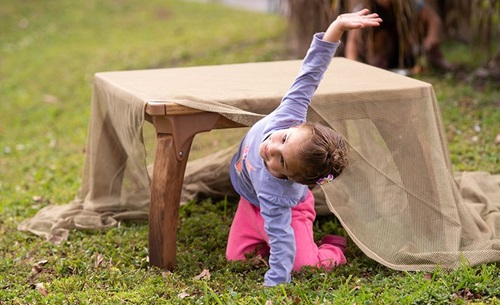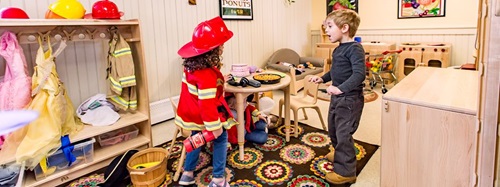Seeing is Believing: Visible Thought in Dramatic Play
| February 2005The home-living area in a busy childcare center has hummed all afternoon. Three-year-old Jared busily packs several large purses full of play food and clothes, dons an oversized sport jacket, picks up some keys, and announces, “I’m going to the store. Do you want to come?” On the other side of the room, Paige and Sarah cook “bug pizza.” They giggle uncontrollably as they try to feed it first to one child, then to another.
At a quick glance, Jared, Paige, and Sarah—fully engaged in their play—seem to be simply doing what children do best, playing and pretending. Early childhood teachers, however, look at play in the preschool years through the lens of thought, language development, and literacy. Roskos and Christie emphasize that play provides a lens through which adults can witness children’s knowledge, feelings, and abilities, and also “makes visible children’s thinking” (2001, 66).
If play does reveal the underlying thinking patterns of children, how can teachers see the thoughts behind the play? What tools are needed by educators to more fully understand the significance of play and its place in language development?
X-ray vision
Early childhood educators want to look beneath the surface of play to reveal the thought processes that guide children’s actions. The thinking skills foundation a child is building on a daily basis in the preschool classroom becomes evident when we apply X-ray vision—just to borrow a skill from a cartoon superhero. A closer, deeper look at play can reveal children’s learning of concept development, communication, budding social relationships, and very specific literacy skills. How do supporting adults develop this vision, and how do teachers honor play as a part of the process of learning?
Viewing play not just as an activity, but as an expression of thinking, lets adults begin to appreciate how children understand their world, including the world of language. As young children play, they establish important links between action and thought, connections that are the basis of mental processes. Berk and Winsler (1995), in describing theorist Lev Vygotsky’s work, note that play involves an imaginary situation, explicit roles, and implicit rules. Dramatic play is the arena in which all of these components converge.
A skilled teacher, looking beneath the surface of this act, can see the thinking skill behind Julio’s simple act of play. Julio understands symbolism. He can transform a concrete object into a symbolic one (Mellou 1994). During dramatic play, children may operate at more advanced cognitive levels than they do in non-pretend situations, including staying on task for extended lengths of time (Roskos, Christie, & Richgels 2003).
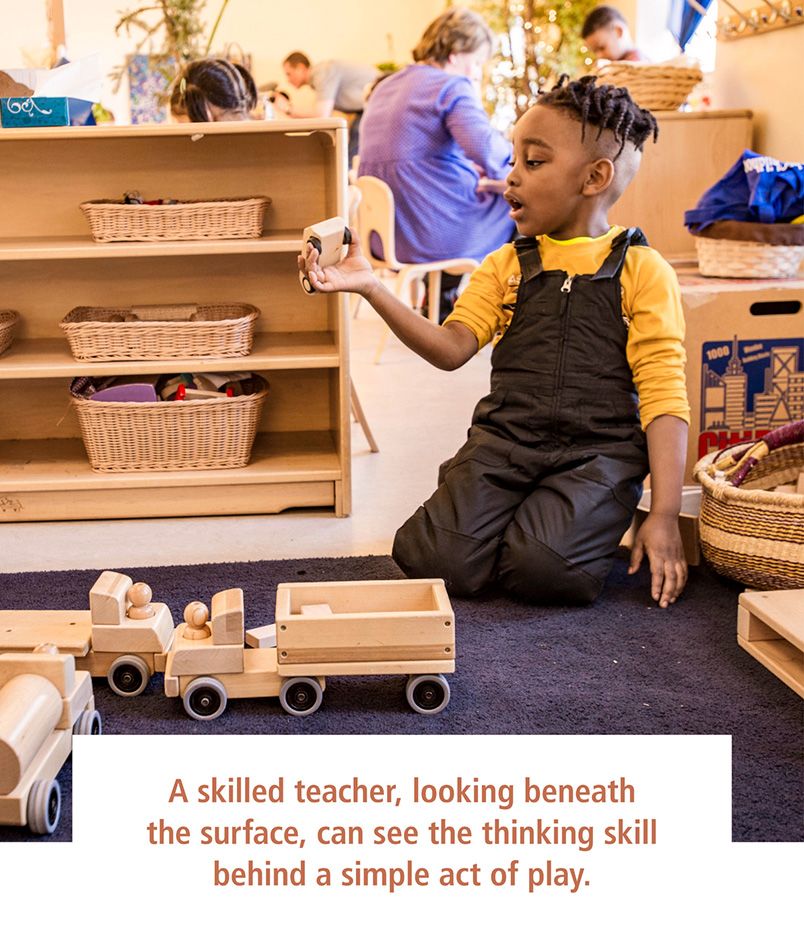
Through thoughtful observation, teachers can discover the links between play and concept development. Children develop concepts and then use them. For instance, a preschool boy makes vital symbolic/real-object connections when he places a red block in front of a toy car, exclaiming “This means Stop!” Thus, “play enables children to make sense of their world [and] develop social and cultural understandings [and] allows children to express their thoughts and feelings…” (Isenberg & Jalongo 2001, 59). As children use symbols, test theories, categorize and organize materials, and solve problems in play, we learn how they think (Cooper & Dever 2001). Thinking skills, such as flexibility, divergency, problem solving, and perspective taking are present when preschoolers play (Hughes 1999; Isenberg & Jalongo 2001). Consider, for example, the child who engages in cognitive flexibility by using a plastic plate as a substitute for a steering wheel, then a pond, and finally a bed for some small plastic horses.
Three-year-olds at the sand table show divergence by first adding water and then gathering a variety of materials to make a dam. Mrs. Chaing helps four-year-old Sarah problem-solve by adding pumpkins and gourds to the home center, where she begins to measure, sort, and arrange them. Perspective taking occurs when children dramatize neighborhood characters such as a mail carrier, hot dog vendor, or a dog walker.
Play’s multiplicity through a 3-D lens
Moviegoers in the 1950s were issued 3-D glasses that transformed the flat images on movie screens into lifelike pictures. Viewing play this way reveals something intricate and true-to-life. We see play’s complex layers, depth, and significance and its role as a vital part of learning. {Play is one way children turn their own experiences into understanding (Puckett & Diffily 2004).
“I’ll be the mother, you be the sister. Will you be the daddy? “Four-year-old Connie picks up a baby doll and points to two classmates. She goes over to the shelf, picks up a small cardboard box, and shakes it over the doll. “You have powder now—nice and dry.”
During this brief episode, Connie reveals her thought processes. She knows that play must be organized and assigns roles (Bodrova et al. 2000). She shows her understanding of mental images and symbolic information as she uses one thing to stand for another (for example, box as powder) (Perry 2004). Connie recalls and repeats the phrase “Nice and dry,” possibly overheard at home during her parents’ care of her baby brother, which illustrates not only memory skills but also her ability to transfer memories from reality to fantasy (Barnett 1990).
A keen observer can see the richness of preschool play and its special place in communication and language development. Connie has shown her knowledge of many linguistic and cognitive skills. As children play, they talk—to themselves, other children, and adults. Children often use vocabulary and syntax that mimic the adult speech they hear around them (Haywood & Perkins 2003).
Dramatic play benefits language in many areas: stimulates language innovation by introducing new words and concepts (especially valuable for second-language learners), motivates language use and practice, develops linguistic awareness, and expands content and concept knowledge (Owocki 2001). Make-believe play is ideally suited to helping children establish connections between concrete and abstract thought. For example, colored craft sticks in the math center become “soccer teams” in the hands of the preschooler who sorts and groups them.
“During dramatic play, children may operate at more advanced cognitive levels than they do in non-pretend situations, including staying on task for extended lengths of time.”
Prereading and reading
Dramatic play relates strongly to the acquisition of global thinking skills, but what about its connection to important reading skills that continue exacting the attention of legislators and educators in the United States (Bodrova & Leong 2004)? Play links directly to specific literacy skills, skills associated with reading. In Dever and Wishon’s observational study (1995), 359 literacy events occurred during several first grade children’s play sessions. Included are picture writing, imitating writing behaviors, scribbling, copying and spelling words, labeling items verbally, pretending to read, and attempting to read. The authors of the study conclude that “play provides a meaningful way for children to assimilate what they are learning about the functions and conventions of print” (p. 40).
The rising emphasis on pre-reading skills before children enter kindergarten (Bredekamp 2004) calls for a reaffirmation of play’s benefits and appropriateness in programs serving the young child. As states adopt specific early childhood education guidelines in all developmental areas, language and literacy skills assume a prominent place in preschool curricula. Criteria from the Texas Prekindergarten Curriculum Guidelines, for example, target 10 areas of literacy development and include over 60 guidelines ranging from listening comprehension to phonological and letter knowledge, to early word recognition and writing skills (Texas Education Agency 1999).
Early childhood teachers see the reading and writing skills manifested in pretend play and carefully plan classroom opportunities that foster those skills: recording children’s dictated stories, stetting up class mailboxes, or using Rebus recipe cards during cooking. The child’s ability to read and write has deep roots in dramatic play. Isenberg and Jalongo indicate that “children’s first attempts at reading and writing often occur during dramatic play, as they read environmental print, make shopping lists, or play school” (2001, 63).
The panoramic view of play
Having emphasized the validation of play as a child’s work the significance of concept development and play, and play’s place in the foundations of learning, it is also important for the practitioner to step back and place play in a larger context—the child as a whole. Just as a panoramic print shows the breadth of a scene, the total play environment carefully planned and arranged captures play’s key place in the learning schema of children, whether acquiring specific language skills or developing social awareness.
Appropriate practice in the preschool years highlights children’s developmental need to play and calls for educators to maintain a primary focus on play as they plan programs involving young children (Bredekamp & Copple 1997). Relying on research, preschool educators have demonstrated that most, if not all, elements of a rich emergent literacy program are found in the play behaviors of young children, both through naturally occurring play scenarios (Roskos 1991) and enriched literacy environments (Neuman & Roskos 1990; Owocki 2001). Success for young children in language and literacy contexts requires not only accountability of early childhood teachers but their understanding of appropriate instructional strategies. Teachers can implement literacy standards in the early childhood classroom while maintaining a developmentally appropriate curriculum (Bodrova, Leong, & Paynter 1999).
Children’s thought becomes visible through play. Dramatic play is a lens through which the process of children’s learning becomes readily visible to early childhood educators. Thus it is essential to maintain environments that validate dramatic play as a useful, necessary element in the young child’s education.
Teachers plan with all the aspects of play in mind. In a preschool classroom, a multivisual approach can include all the different approaches to learning that dramatic play encompasses. Following are tips for using a multivisual approach.
Turn on the X-ray. A teacher can confirm the place of play in an early literacy program for parents, administrators, and fellow teachers in several ways. One way is to enlarge children’s photographs into posters showing children engaged in dramatic play. (Some instant photo labs do this for a nominal fee.) Surround the poster with cartoon balloon outlines detailing the thinking and planning that occur in making the particular play scenario unfold.
Or a preschool teacher could videotape 15 to 20 minutes of play in the housekeeping area of the classroom. Review the tape and list all of the concepts that the children’s play reflects during the scene. Be sure to use familiar terms rather than educational jargon. Share the video at a staff meeting or send it home with parents, along with a copy of the list of concepts. Invite viewers to add insights of their own to the list.
Plan in 3-D. Use a concrete visual image as a planning technique to dramatize the multidimensional aspects of play for families and colleagues. Creating the image of a layer cake, begin with the surface activity (the icing), and then detail the multiple layers beneath. Brainstorm with colleagues for ideas of other images to illustrate the ways that dramatic play facilitates learning. The possibilities are endless—from onions to architecture. There are myriad ways to frame learning within the context of play.
Wipe off the reading glasses. Emphasize the many language and literacy skills that are acquired through dramatic play. Set up play centers that particularly invite reading and writing activities, such as a bookstore, restaurant, or market. Add books, print, and writing materials to all areas in the room. Remember to include the important step of communicating these play activities to families and validating them through newsletters, lesson plans, and bulletin board photo displays of children exploring books or experimenting with writing.
Focus on the big picture. Step back, plan for, and celebrate children’s overall development. Emphasize relationships among and between children through activities that increase language development: painting with a buddy at the easel, playing partner games such as I Spy, or engaging in puppet play. Make global connections between play and learning and show the link between abstract thinking and play by adding general items to the home center, such as colored blocks for food or straws for utensils. Follow a daily schedule with large blocks of time (45 minutes as a minimum) to allow for learning to emerge and to give children freedom to move throughout the room exploring centers that are equipped with a variety of materials for many areas: hats, small suitcases, scarves, or discarded computers.
Conclusion: Seeing is believing By opening up a new vision of play, educators can foster environments that treasure and value play. Whatever lens is used or viewpoint is taken, the central role of dramatic play remains strong in all learning, particularly language and literacy.
To echo the thoughts of Saint-Exupery, “It is only with the heart that one can see rightly. What is essential is invisible to the eye” ([1943] 1971, 70). Much of what is absolutely essential about play is initially invisible to the eye of the casual observer. With just the right perspective, the deep thought that accompanies children’s play can become visible and, once evident, celebrated and enhanced.

